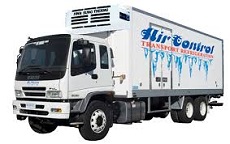
Unless we work in the food industry, we don’t realize the long chain of things that need to happen before food gets from the field to our refrigerators. Food transport may span thousands of miles, and food may change hands multiple times before it makes it to the supermarket shelf, and thence to our homes.
The food “cold chain”, as it’s called, aims to maximize freshness and minimize food-borne illnesses, as a break in the chain can be deadly. The chain is a highly interconnected system of high-tech processing facilities, transport vehicles and shipping containers, which work together out of the view of the general public to preserve food quality and safety.
Public Concern
Unsurprisingly, food safety is a major public concern—according to a recent survey by Emercon, 9 out of 10 adults are somewhat worried about it. This isn’t too surprising when you consider that almost 50 million Americans get sick from a food-borne illness every year. So ensuring that food is kept cold and free from pathogens and spoilage is crucial.
Way back when, standards were somewhat more lax than they are now. For example, to check that the food wasn’t spoiled, a thermometer would be inserted at the beginning and the end of the journey, with the assumption that if they showed the same temperature, the food was fine. Unfortunately this reasoning was a little skewed; it assumed that there had been no changes in temperature throughout the trip, whereas because of the cargo changing hands, it’s perfectly possible for localized hotspots to arise at any point in the chain, increasing the risk of foodborne illnesses.
Regulatory Issues
The US FDA’s recently implemented Food Modernization Act brings all of this into focus, its purpose to regulate national and international foods to prevent such issues (although with a Trump Administration, the future of regulations is at this point somewhat in doubt). Many farmers still rely on paper-based processes to comply with the regulations, but this is costly and time-consuming. What’s needed is more automation to help control labour costs and ensure that food is properly tagged and its location and condition can be identified at each step of the process as it moves through the chain.
One possibility is to use a barcode or a QR label to ensure that food packages can be scanned and registered at each new location. Another solution is to use a passive RFID tag, which can not only allow the shipment to be tracked along the cold chain, but can also be used to improve farming practices based on maximizing product quality, and minimizing cost in terms of when best to add labour and new equipment.
Foodbots
But we can go further than just using RFID tags to read the location and quality of goods. The burgeoning automation industry, having already revolutionized automotive plants, is starting to move toward other sectors, and is itching to get its metallic claws into agriculture and food preparation. One obvious place for robotic technology is in food processing plants to help ease labour issues—where human workers can suffer injuries from performing the same repetitive tasks over and over again—but that’s not the only place that automation can be involved.
The use of robots in sanitary food preparation is also a huge area for growth, especially with the recent October 2016 release of the first ever industry standard for minimum sanitary requirements for the design, materials, fabrication and installation of robotic automation systems (the 3-A Sanitary Standard for Robot-based Automation Systems). The standard applies to food processing, preparation, and other applications or industries where similar automation must occur in a sanitary fashion.
Based on this standard, there are many ways that robots can be used in food preparation and packaging. For example, sanitary robots are able to operate food-grade metal detectors, extract ice-cream cones from their moulds, and handle fresh produce. At the end of the day they can wash conveyor belts and surrounding equipment, and even each other. And of course, because robots don’t catch diseases, there is much less scope for pathogens to be transferred to food via human operators. With everything tagged and manufactured by robots, the cold chain will be more secure than ever.






